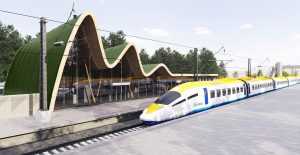 RB Rail AS has launched the Rail Baltica energy subsystem tender covering the design and construction of the electrification for the entire corridor, the rail line in Estonia, Latvia, and Lithuania.
RB Rail AS has launched the Rail Baltica energy subsystem tender covering the design and construction of the electrification for the entire corridor, the rail line in Estonia, Latvia, and Lithuania.
The deployment of the energy subsystem in a consolidated way from Tallinn to the Lithuania – Poland border and from Kaunas to Vilnius, makes the Rail Baltica electrification the largest railway electrification project in Europe implemented as a single project.
The procurement will be organised in two stages and is planned to be concluded by the end of 2023. The energy subsystem scope covers key components such as high voltage connection points, for connection of traction power substations to the public high voltage electrical grids, traction power substations, overhead contact system, energy control command system, and other components directly linked to energy subsystem.
In practice the chosen approach also means the need to address an extra level of complexity stemming from border effects and different legislations – in Rail Baltica, the missing link on the North Sea-Baltic core network corridor, there are three border sections between Estonia, Latvia, Lithuania, and Poland.
The electrification of the 870 km double track line requires more than 2 000 km of catenary system, around 4 350 tonnes of copper materials, and 50 000 masts to be installed. Electricity consumed by Rail Baltica will represent 900 GW.h / year, leading to an estimated ~3% increase in the national consumption in every Baltic State.
The proposed new electrification architecture Static Frequency Converters (SFC) on a project of such scale is also one of a kind providing flexible and efficient integration between countries.
At the beginning of 2021, the RB Rail AS selected an engineering service provider (ENE Engineer) for the global project energy subsystem deployment. The association of DB Engineering & Consulting GmbH, Idom Consulting, Engineering, Architecture and Italferr was announced as the winner in an international tender.
The implementation of the entire Rail Baltica project is financed by the three national states and co-funding from the European Union up to 85% of the total eligible costs, in particular in the framework of the Connecting Europe Facility (CEF) funding instrument.
For a few years now and even before the European Green Deal, the Rail Baltica project implementers have been analysing the environmental impact of the line, regarding the energy used for the train traction. “Strong conditions regarding minimization of environmental impact are an integral part of Rail Baltica electrification. For example, the energy efficiency of the overall traction chain will be more than 85%, and a lifetime of components will be 50 years or more,” Jean-Marc Bedmar, Head of Systems and Operation department at RB Rail said.
Share on:



